Managing Financial Resources for J Sainsbury PLC: A Detailed Report
VerifiedAdded on 2020/02/03
|13
|4253
|49
Report
AI Summary
This report provides a comprehensive analysis of financial resource management, specifically focusing on J Sainsbury PLC. It begins with an introduction to financial management and its importance, followed by an examination of various sources of finance, both internal and external, along with their implications. The report then delves into the factors influencing the selection of appropriate financing sources, the associated costs, and the significance of financial planning. It further explores the information needs of different decision-makers within the company and the impact of financial activities on financial statements. A detailed cash budget for J Sainsbury PLC is presented, along with calculations of unit costs. The report also discusses the viability of a project using investment appraisal techniques. Finally, it covers the different types of financial statements, their application in various business contexts, and the interpretation of these statements using relevant financial ratios. The report concludes with a summary of the key findings and insights.
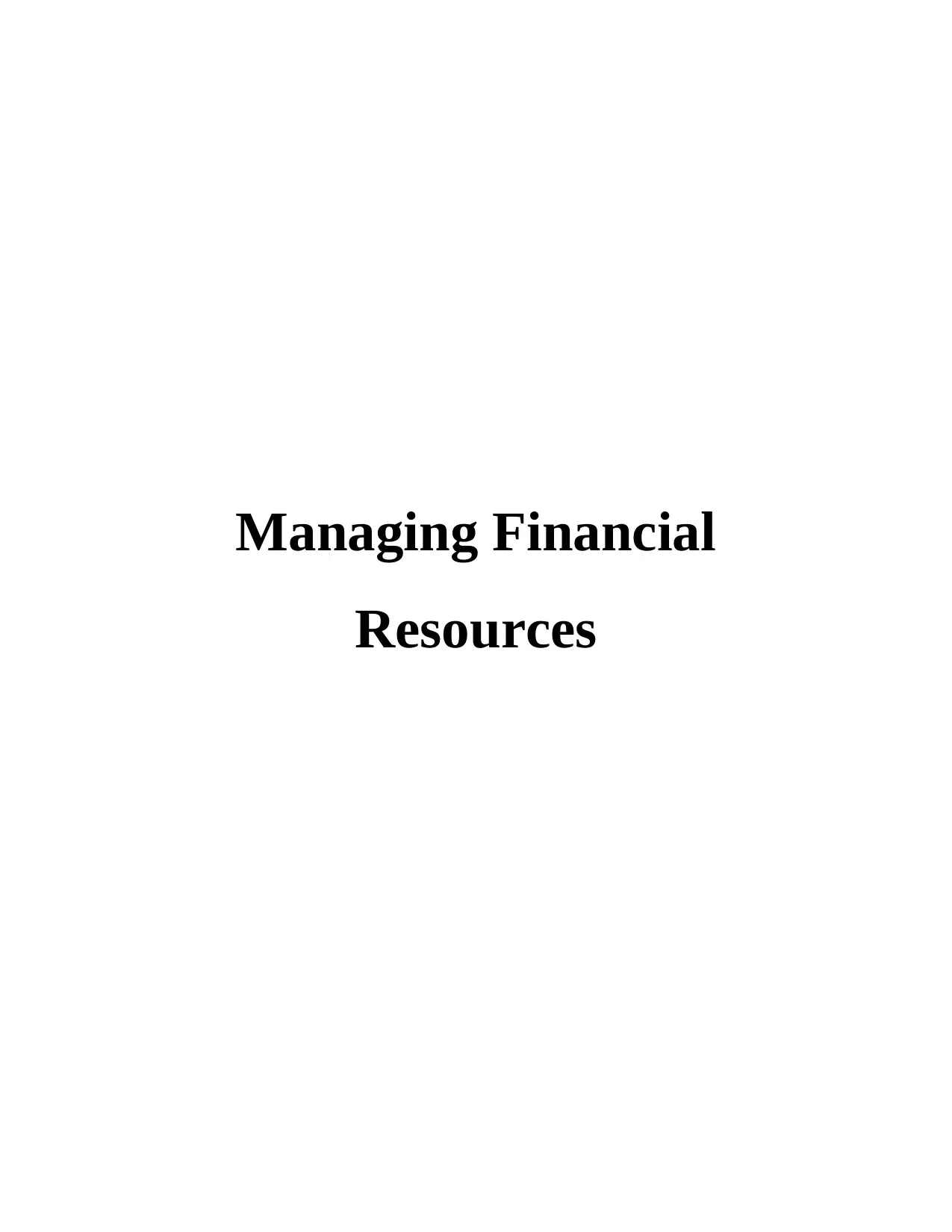
Managing Financial
Resources
Resources
Paraphrase This Document
Need a fresh take? Get an instant paraphrase of this document with our AI Paraphraser
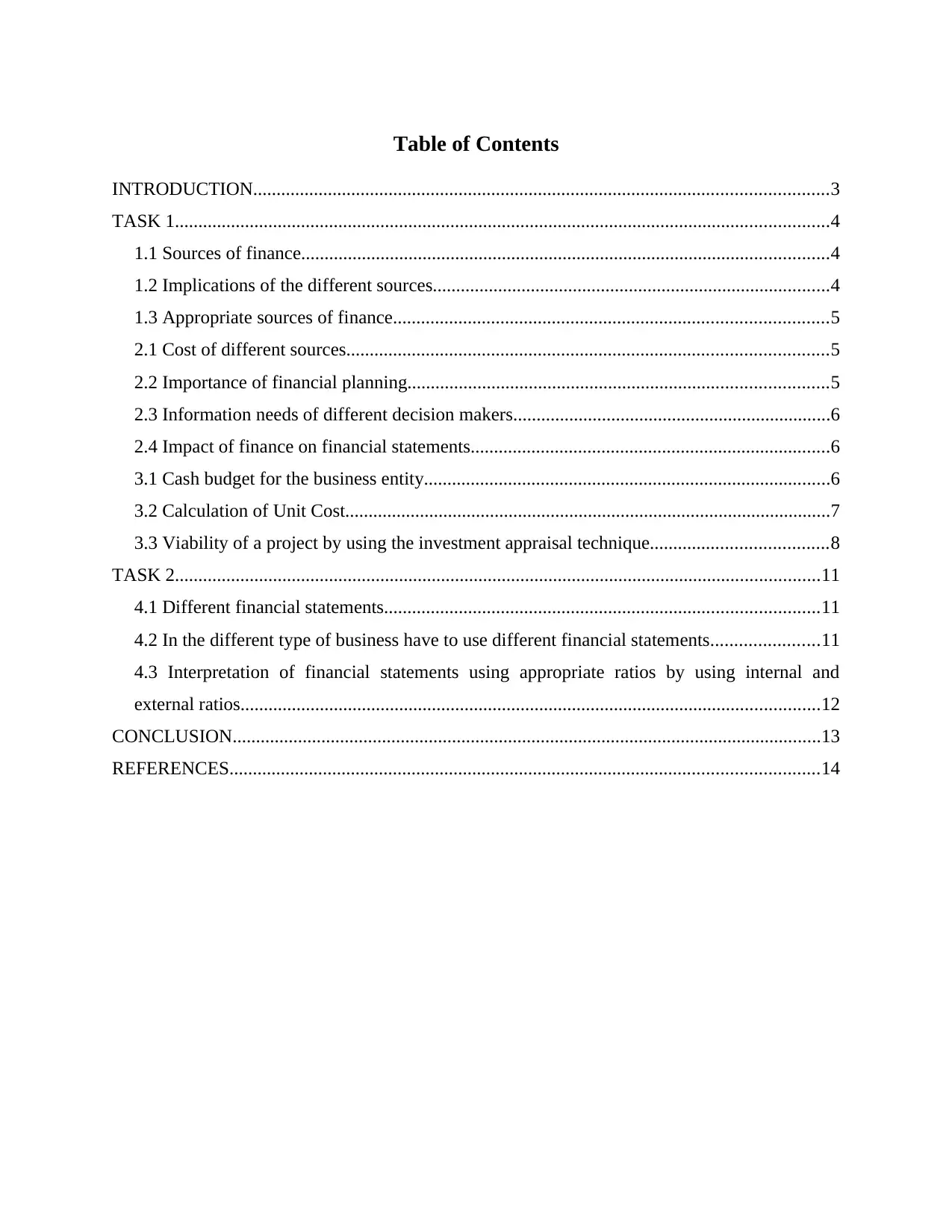
Table of Contents
INTRODUCTION...........................................................................................................................3
TASK 1............................................................................................................................................4
1.1 Sources of finance.................................................................................................................4
1.2 Implications of the different sources.....................................................................................4
1.3 Appropriate sources of finance.............................................................................................5
2.1 Cost of different sources.......................................................................................................5
2.2 Importance of financial planning..........................................................................................5
2.3 Information needs of different decision makers....................................................................6
2.4 Impact of finance on financial statements.............................................................................6
3.1 Cash budget for the business entity.......................................................................................6
3.2 Calculation of Unit Cost........................................................................................................7
3.3 Viability of a project by using the investment appraisal technique......................................8
TASK 2..........................................................................................................................................11
4.1 Different financial statements.............................................................................................11
4.2 In the different type of business have to use different financial statements.......................11
4.3 Interpretation of financial statements using appropriate ratios by using internal and
external ratios............................................................................................................................12
CONCLUSION..............................................................................................................................13
REFERENCES..............................................................................................................................14
INTRODUCTION...........................................................................................................................3
TASK 1............................................................................................................................................4
1.1 Sources of finance.................................................................................................................4
1.2 Implications of the different sources.....................................................................................4
1.3 Appropriate sources of finance.............................................................................................5
2.1 Cost of different sources.......................................................................................................5
2.2 Importance of financial planning..........................................................................................5
2.3 Information needs of different decision makers....................................................................6
2.4 Impact of finance on financial statements.............................................................................6
3.1 Cash budget for the business entity.......................................................................................6
3.2 Calculation of Unit Cost........................................................................................................7
3.3 Viability of a project by using the investment appraisal technique......................................8
TASK 2..........................................................................................................................................11
4.1 Different financial statements.............................................................................................11
4.2 In the different type of business have to use different financial statements.......................11
4.3 Interpretation of financial statements using appropriate ratios by using internal and
external ratios............................................................................................................................12
CONCLUSION..............................................................................................................................13
REFERENCES..............................................................................................................................14
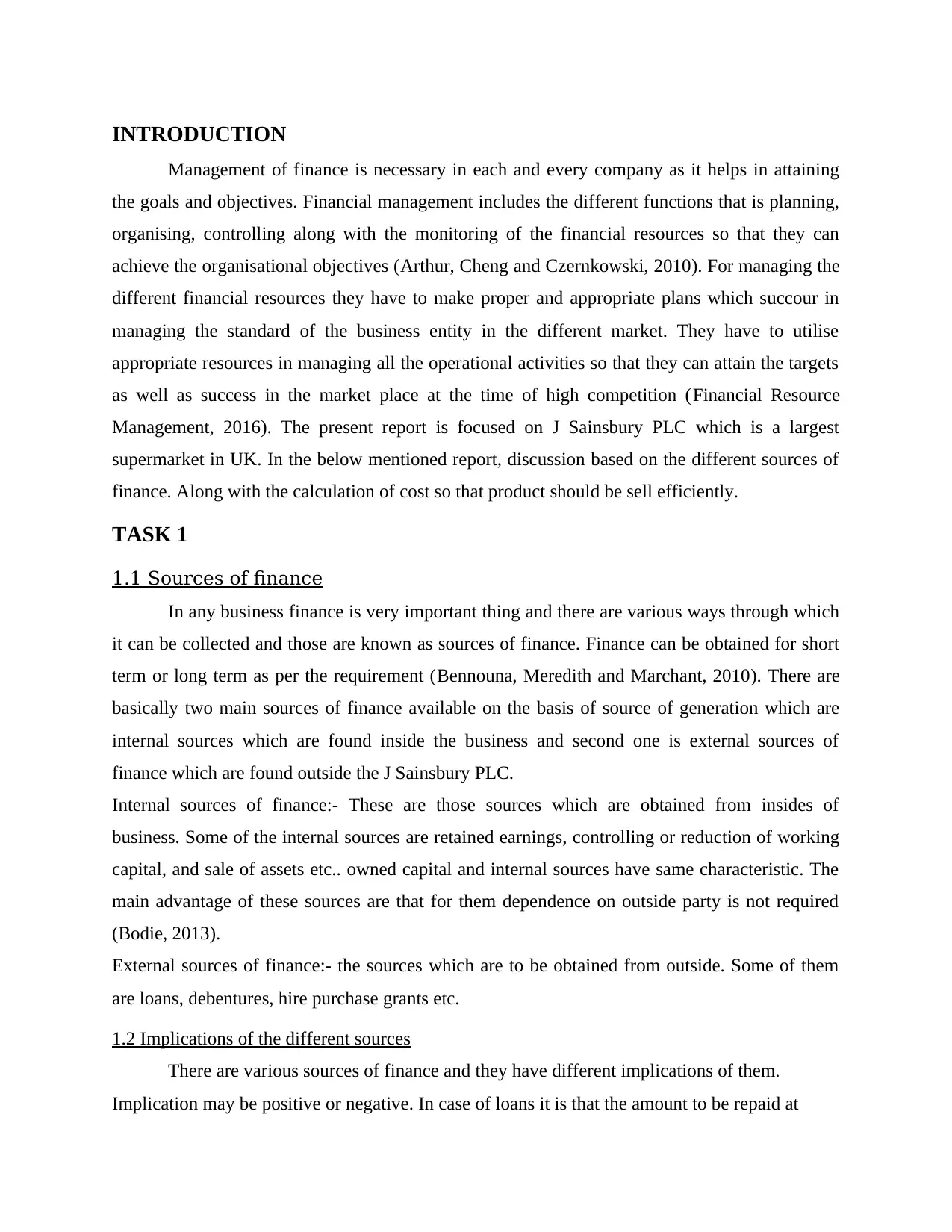
INTRODUCTION
Management of finance is necessary in each and every company as it helps in attaining
the goals and objectives. Financial management includes the different functions that is planning,
organising, controlling along with the monitoring of the financial resources so that they can
achieve the organisational objectives (Arthur, Cheng and Czernkowski, 2010). For managing the
different financial resources they have to make proper and appropriate plans which succour in
managing the standard of the business entity in the different market. They have to utilise
appropriate resources in managing all the operational activities so that they can attain the targets
as well as success in the market place at the time of high competition (Financial Resource
Management, 2016). The present report is focused on J Sainsbury PLC which is a largest
supermarket in UK. In the below mentioned report, discussion based on the different sources of
finance. Along with the calculation of cost so that product should be sell efficiently.
TASK 1
1.1 Sources of finance
In any business finance is very important thing and there are various ways through which
it can be collected and those are known as sources of finance. Finance can be obtained for short
term or long term as per the requirement (Bennouna, Meredith and Marchant, 2010). There are
basically two main sources of finance available on the basis of source of generation which are
internal sources which are found inside the business and second one is external sources of
finance which are found outside the J Sainsbury PLC.
Internal sources of finance:- These are those sources which are obtained from insides of
business. Some of the internal sources are retained earnings, controlling or reduction of working
capital, and sale of assets etc.. owned capital and internal sources have same characteristic. The
main advantage of these sources are that for them dependence on outside party is not required
(Bodie, 2013).
External sources of finance:- the sources which are to be obtained from outside. Some of them
are loans, debentures, hire purchase grants etc.
1.2 Implications of the different sources
There are various sources of finance and they have different implications of them.
Implication may be positive or negative. In case of loans it is that the amount to be repaid at
Management of finance is necessary in each and every company as it helps in attaining
the goals and objectives. Financial management includes the different functions that is planning,
organising, controlling along with the monitoring of the financial resources so that they can
achieve the organisational objectives (Arthur, Cheng and Czernkowski, 2010). For managing the
different financial resources they have to make proper and appropriate plans which succour in
managing the standard of the business entity in the different market. They have to utilise
appropriate resources in managing all the operational activities so that they can attain the targets
as well as success in the market place at the time of high competition (Financial Resource
Management, 2016). The present report is focused on J Sainsbury PLC which is a largest
supermarket in UK. In the below mentioned report, discussion based on the different sources of
finance. Along with the calculation of cost so that product should be sell efficiently.
TASK 1
1.1 Sources of finance
In any business finance is very important thing and there are various ways through which
it can be collected and those are known as sources of finance. Finance can be obtained for short
term or long term as per the requirement (Bennouna, Meredith and Marchant, 2010). There are
basically two main sources of finance available on the basis of source of generation which are
internal sources which are found inside the business and second one is external sources of
finance which are found outside the J Sainsbury PLC.
Internal sources of finance:- These are those sources which are obtained from insides of
business. Some of the internal sources are retained earnings, controlling or reduction of working
capital, and sale of assets etc.. owned capital and internal sources have same characteristic. The
main advantage of these sources are that for them dependence on outside party is not required
(Bodie, 2013).
External sources of finance:- the sources which are to be obtained from outside. Some of them
are loans, debentures, hire purchase grants etc.
1.2 Implications of the different sources
There are various sources of finance and they have different implications of them.
Implication may be positive or negative. In case of loans it is that the amount to be repaid at
⊘ This is a preview!⊘
Do you want full access?
Subscribe today to unlock all pages.

Trusted by 1+ million students worldwide
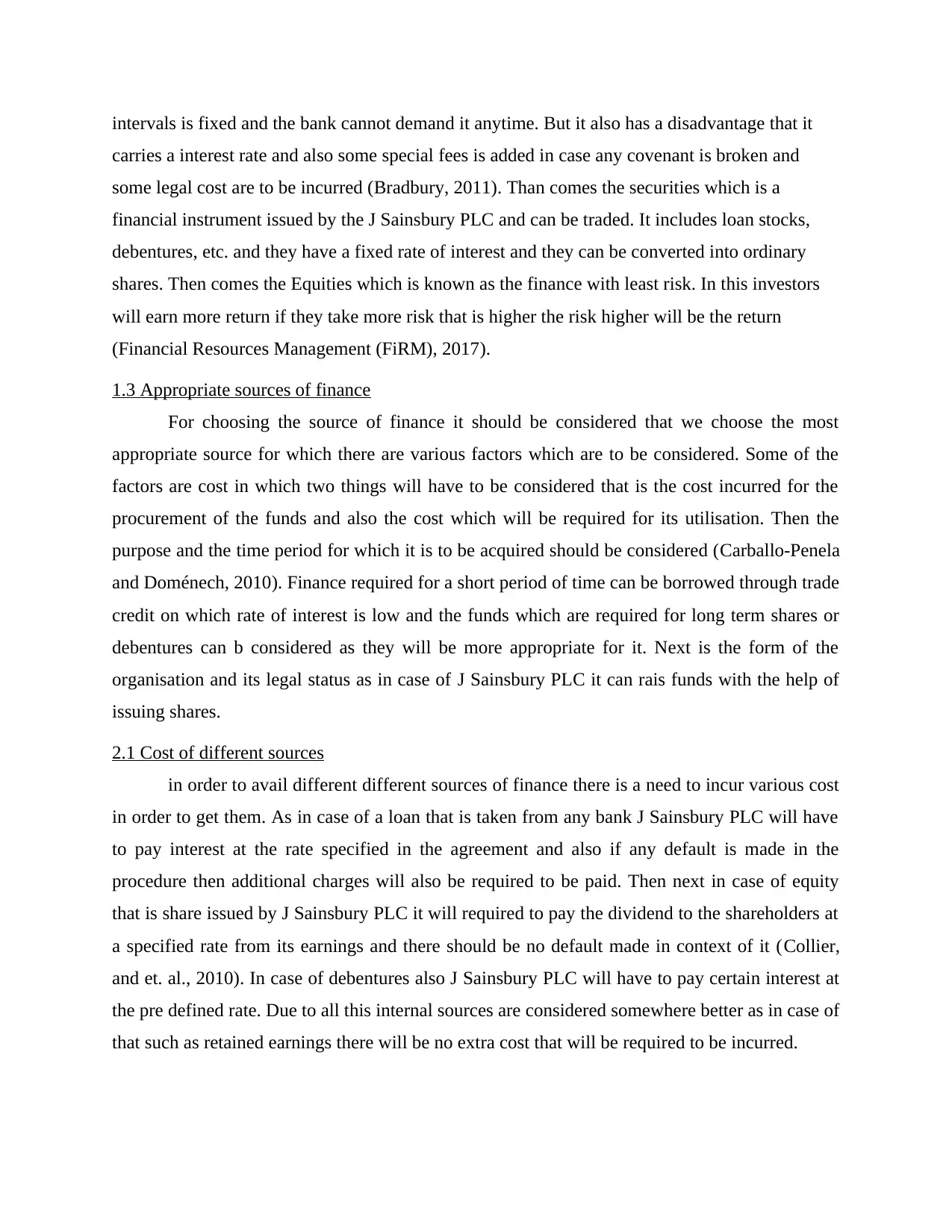
intervals is fixed and the bank cannot demand it anytime. But it also has a disadvantage that it
carries a interest rate and also some special fees is added in case any covenant is broken and
some legal cost are to be incurred (Bradbury, 2011). Than comes the securities which is a
financial instrument issued by the J Sainsbury PLC and can be traded. It includes loan stocks,
debentures, etc. and they have a fixed rate of interest and they can be converted into ordinary
shares. Then comes the Equities which is known as the finance with least risk. In this investors
will earn more return if they take more risk that is higher the risk higher will be the return
(Financial Resources Management (FiRM), 2017).
1.3 Appropriate sources of finance
For choosing the source of finance it should be considered that we choose the most
appropriate source for which there are various factors which are to be considered. Some of the
factors are cost in which two things will have to be considered that is the cost incurred for the
procurement of the funds and also the cost which will be required for its utilisation. Then the
purpose and the time period for which it is to be acquired should be considered (Carballo-Penela
and Doménech, 2010). Finance required for a short period of time can be borrowed through trade
credit on which rate of interest is low and the funds which are required for long term shares or
debentures can b considered as they will be more appropriate for it. Next is the form of the
organisation and its legal status as in case of J Sainsbury PLC it can rais funds with the help of
issuing shares.
2.1 Cost of different sources
in order to avail different different sources of finance there is a need to incur various cost
in order to get them. As in case of a loan that is taken from any bank J Sainsbury PLC will have
to pay interest at the rate specified in the agreement and also if any default is made in the
procedure then additional charges will also be required to be paid. Then next in case of equity
that is share issued by J Sainsbury PLC it will required to pay the dividend to the shareholders at
a specified rate from its earnings and there should be no default made in context of it (Collier,
and et. al., 2010). In case of debentures also J Sainsbury PLC will have to pay certain interest at
the pre defined rate. Due to all this internal sources are considered somewhere better as in case of
that such as retained earnings there will be no extra cost that will be required to be incurred.
carries a interest rate and also some special fees is added in case any covenant is broken and
some legal cost are to be incurred (Bradbury, 2011). Than comes the securities which is a
financial instrument issued by the J Sainsbury PLC and can be traded. It includes loan stocks,
debentures, etc. and they have a fixed rate of interest and they can be converted into ordinary
shares. Then comes the Equities which is known as the finance with least risk. In this investors
will earn more return if they take more risk that is higher the risk higher will be the return
(Financial Resources Management (FiRM), 2017).
1.3 Appropriate sources of finance
For choosing the source of finance it should be considered that we choose the most
appropriate source for which there are various factors which are to be considered. Some of the
factors are cost in which two things will have to be considered that is the cost incurred for the
procurement of the funds and also the cost which will be required for its utilisation. Then the
purpose and the time period for which it is to be acquired should be considered (Carballo-Penela
and Doménech, 2010). Finance required for a short period of time can be borrowed through trade
credit on which rate of interest is low and the funds which are required for long term shares or
debentures can b considered as they will be more appropriate for it. Next is the form of the
organisation and its legal status as in case of J Sainsbury PLC it can rais funds with the help of
issuing shares.
2.1 Cost of different sources
in order to avail different different sources of finance there is a need to incur various cost
in order to get them. As in case of a loan that is taken from any bank J Sainsbury PLC will have
to pay interest at the rate specified in the agreement and also if any default is made in the
procedure then additional charges will also be required to be paid. Then next in case of equity
that is share issued by J Sainsbury PLC it will required to pay the dividend to the shareholders at
a specified rate from its earnings and there should be no default made in context of it (Collier,
and et. al., 2010). In case of debentures also J Sainsbury PLC will have to pay certain interest at
the pre defined rate. Due to all this internal sources are considered somewhere better as in case of
that such as retained earnings there will be no extra cost that will be required to be incurred.
Paraphrase This Document
Need a fresh take? Get an instant paraphrase of this document with our AI Paraphraser
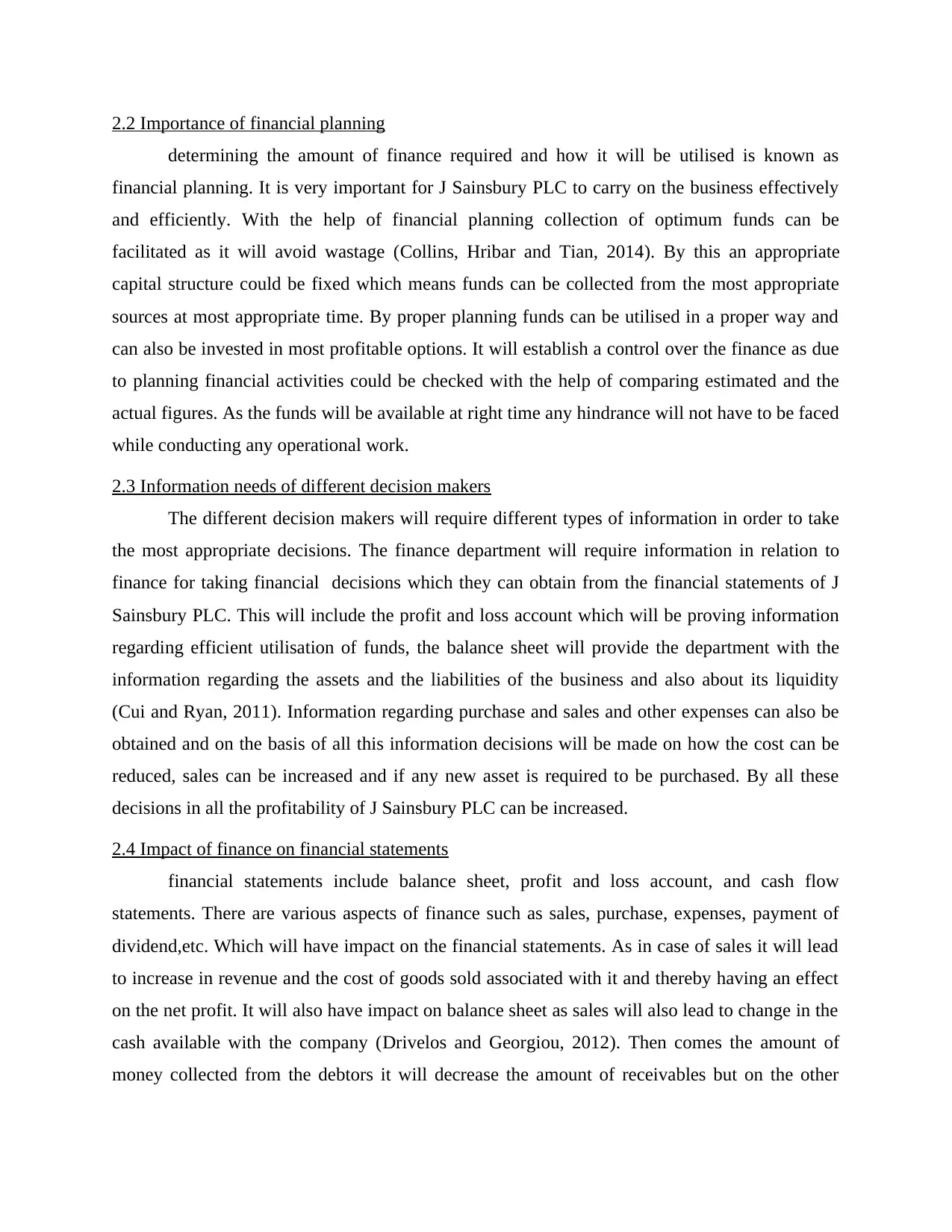
2.2 Importance of financial planning
determining the amount of finance required and how it will be utilised is known as
financial planning. It is very important for J Sainsbury PLC to carry on the business effectively
and efficiently. With the help of financial planning collection of optimum funds can be
facilitated as it will avoid wastage (Collins, Hribar and Tian, 2014). By this an appropriate
capital structure could be fixed which means funds can be collected from the most appropriate
sources at most appropriate time. By proper planning funds can be utilised in a proper way and
can also be invested in most profitable options. It will establish a control over the finance as due
to planning financial activities could be checked with the help of comparing estimated and the
actual figures. As the funds will be available at right time any hindrance will not have to be faced
while conducting any operational work.
2.3 Information needs of different decision makers
The different decision makers will require different types of information in order to take
the most appropriate decisions. The finance department will require information in relation to
finance for taking financial decisions which they can obtain from the financial statements of J
Sainsbury PLC. This will include the profit and loss account which will be proving information
regarding efficient utilisation of funds, the balance sheet will provide the department with the
information regarding the assets and the liabilities of the business and also about its liquidity
(Cui and Ryan, 2011). Information regarding purchase and sales and other expenses can also be
obtained and on the basis of all this information decisions will be made on how the cost can be
reduced, sales can be increased and if any new asset is required to be purchased. By all these
decisions in all the profitability of J Sainsbury PLC can be increased.
2.4 Impact of finance on financial statements
financial statements include balance sheet, profit and loss account, and cash flow
statements. There are various aspects of finance such as sales, purchase, expenses, payment of
dividend,etc. Which will have impact on the financial statements. As in case of sales it will lead
to increase in revenue and the cost of goods sold associated with it and thereby having an effect
on the net profit. It will also have impact on balance sheet as sales will also lead to change in the
cash available with the company (Drivelos and Georgiou, 2012). Then comes the amount of
money collected from the debtors it will decrease the amount of receivables but on the other
determining the amount of finance required and how it will be utilised is known as
financial planning. It is very important for J Sainsbury PLC to carry on the business effectively
and efficiently. With the help of financial planning collection of optimum funds can be
facilitated as it will avoid wastage (Collins, Hribar and Tian, 2014). By this an appropriate
capital structure could be fixed which means funds can be collected from the most appropriate
sources at most appropriate time. By proper planning funds can be utilised in a proper way and
can also be invested in most profitable options. It will establish a control over the finance as due
to planning financial activities could be checked with the help of comparing estimated and the
actual figures. As the funds will be available at right time any hindrance will not have to be faced
while conducting any operational work.
2.3 Information needs of different decision makers
The different decision makers will require different types of information in order to take
the most appropriate decisions. The finance department will require information in relation to
finance for taking financial decisions which they can obtain from the financial statements of J
Sainsbury PLC. This will include the profit and loss account which will be proving information
regarding efficient utilisation of funds, the balance sheet will provide the department with the
information regarding the assets and the liabilities of the business and also about its liquidity
(Cui and Ryan, 2011). Information regarding purchase and sales and other expenses can also be
obtained and on the basis of all this information decisions will be made on how the cost can be
reduced, sales can be increased and if any new asset is required to be purchased. By all these
decisions in all the profitability of J Sainsbury PLC can be increased.
2.4 Impact of finance on financial statements
financial statements include balance sheet, profit and loss account, and cash flow
statements. There are various aspects of finance such as sales, purchase, expenses, payment of
dividend,etc. Which will have impact on the financial statements. As in case of sales it will lead
to increase in revenue and the cost of goods sold associated with it and thereby having an effect
on the net profit. It will also have impact on balance sheet as sales will also lead to change in the
cash available with the company (Drivelos and Georgiou, 2012). Then comes the amount of
money collected from the debtors it will decrease the amount of receivables but on the other
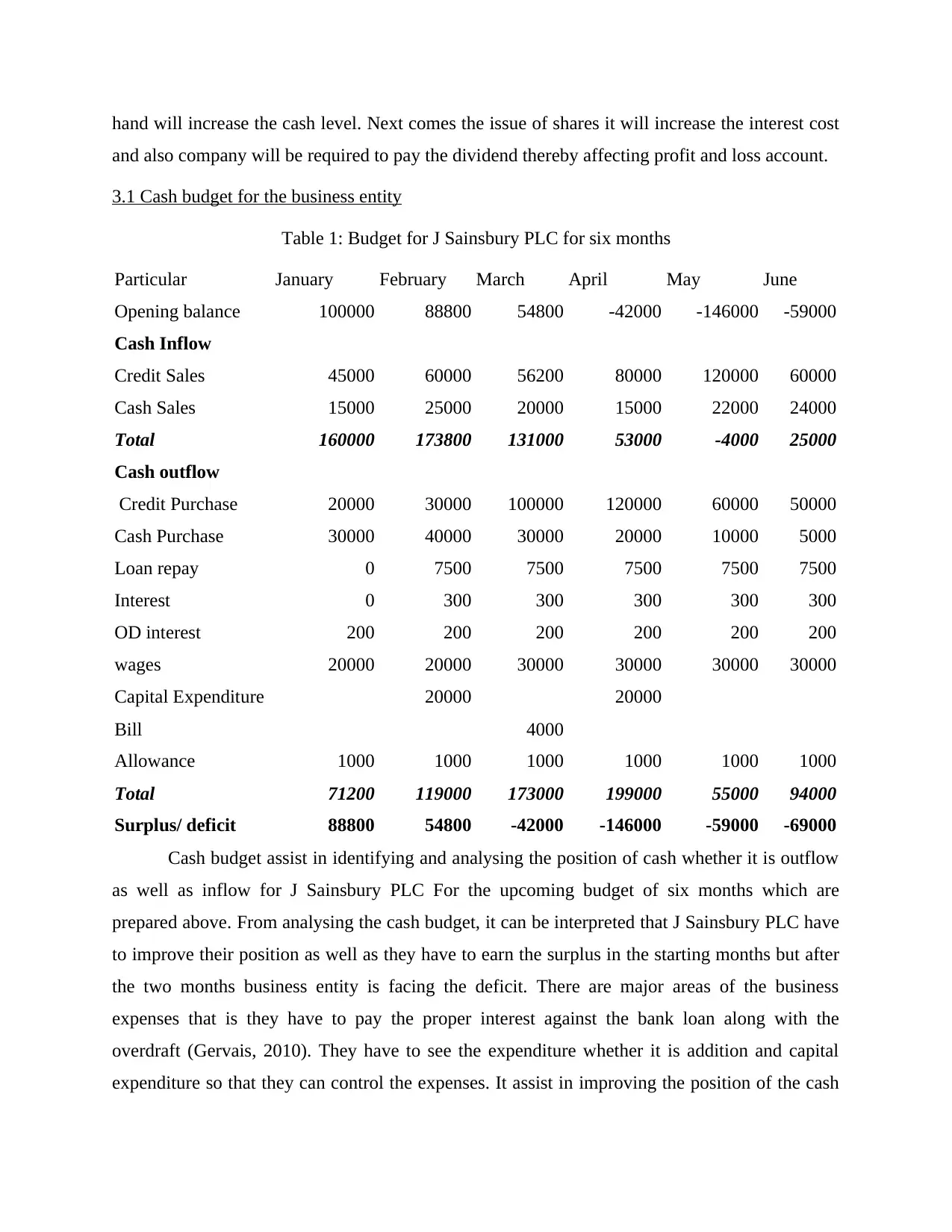
hand will increase the cash level. Next comes the issue of shares it will increase the interest cost
and also company will be required to pay the dividend thereby affecting profit and loss account.
3.1 Cash budget for the business entity
Table 1: Budget for J Sainsbury PLC for six months
Particular January February March April May June
Opening balance 100000 88800 54800 -42000 -146000 -59000
Cash Inflow
Credit Sales 45000 60000 56200 80000 120000 60000
Cash Sales 15000 25000 20000 15000 22000 24000
Total 160000 173800 131000 53000 -4000 25000
Cash outflow
Credit Purchase 20000 30000 100000 120000 60000 50000
Cash Purchase 30000 40000 30000 20000 10000 5000
Loan repay 0 7500 7500 7500 7500 7500
Interest 0 300 300 300 300 300
OD interest 200 200 200 200 200 200
wages 20000 20000 30000 30000 30000 30000
Capital Expenditure 20000 20000
Bill 4000
Allowance 1000 1000 1000 1000 1000 1000
Total 71200 119000 173000 199000 55000 94000
Surplus/ deficit 88800 54800 -42000 -146000 -59000 -69000
Cash budget assist in identifying and analysing the position of cash whether it is outflow
as well as inflow for J Sainsbury PLC For the upcoming budget of six months which are
prepared above. From analysing the cash budget, it can be interpreted that J Sainsbury PLC have
to improve their position as well as they have to earn the surplus in the starting months but after
the two months business entity is facing the deficit. There are major areas of the business
expenses that is they have to pay the proper interest against the bank loan along with the
overdraft (Gervais, 2010). They have to see the expenditure whether it is addition and capital
expenditure so that they can control the expenses. It assist in improving the position of the cash
and also company will be required to pay the dividend thereby affecting profit and loss account.
3.1 Cash budget for the business entity
Table 1: Budget for J Sainsbury PLC for six months
Particular January February March April May June
Opening balance 100000 88800 54800 -42000 -146000 -59000
Cash Inflow
Credit Sales 45000 60000 56200 80000 120000 60000
Cash Sales 15000 25000 20000 15000 22000 24000
Total 160000 173800 131000 53000 -4000 25000
Cash outflow
Credit Purchase 20000 30000 100000 120000 60000 50000
Cash Purchase 30000 40000 30000 20000 10000 5000
Loan repay 0 7500 7500 7500 7500 7500
Interest 0 300 300 300 300 300
OD interest 200 200 200 200 200 200
wages 20000 20000 30000 30000 30000 30000
Capital Expenditure 20000 20000
Bill 4000
Allowance 1000 1000 1000 1000 1000 1000
Total 71200 119000 173000 199000 55000 94000
Surplus/ deficit 88800 54800 -42000 -146000 -59000 -69000
Cash budget assist in identifying and analysing the position of cash whether it is outflow
as well as inflow for J Sainsbury PLC For the upcoming budget of six months which are
prepared above. From analysing the cash budget, it can be interpreted that J Sainsbury PLC have
to improve their position as well as they have to earn the surplus in the starting months but after
the two months business entity is facing the deficit. There are major areas of the business
expenses that is they have to pay the proper interest against the bank loan along with the
overdraft (Gervais, 2010). They have to see the expenditure whether it is addition and capital
expenditure so that they can control the expenses. It assist in improving the position of the cash
⊘ This is a preview!⊘
Do you want full access?
Subscribe today to unlock all pages.

Trusted by 1+ million students worldwide
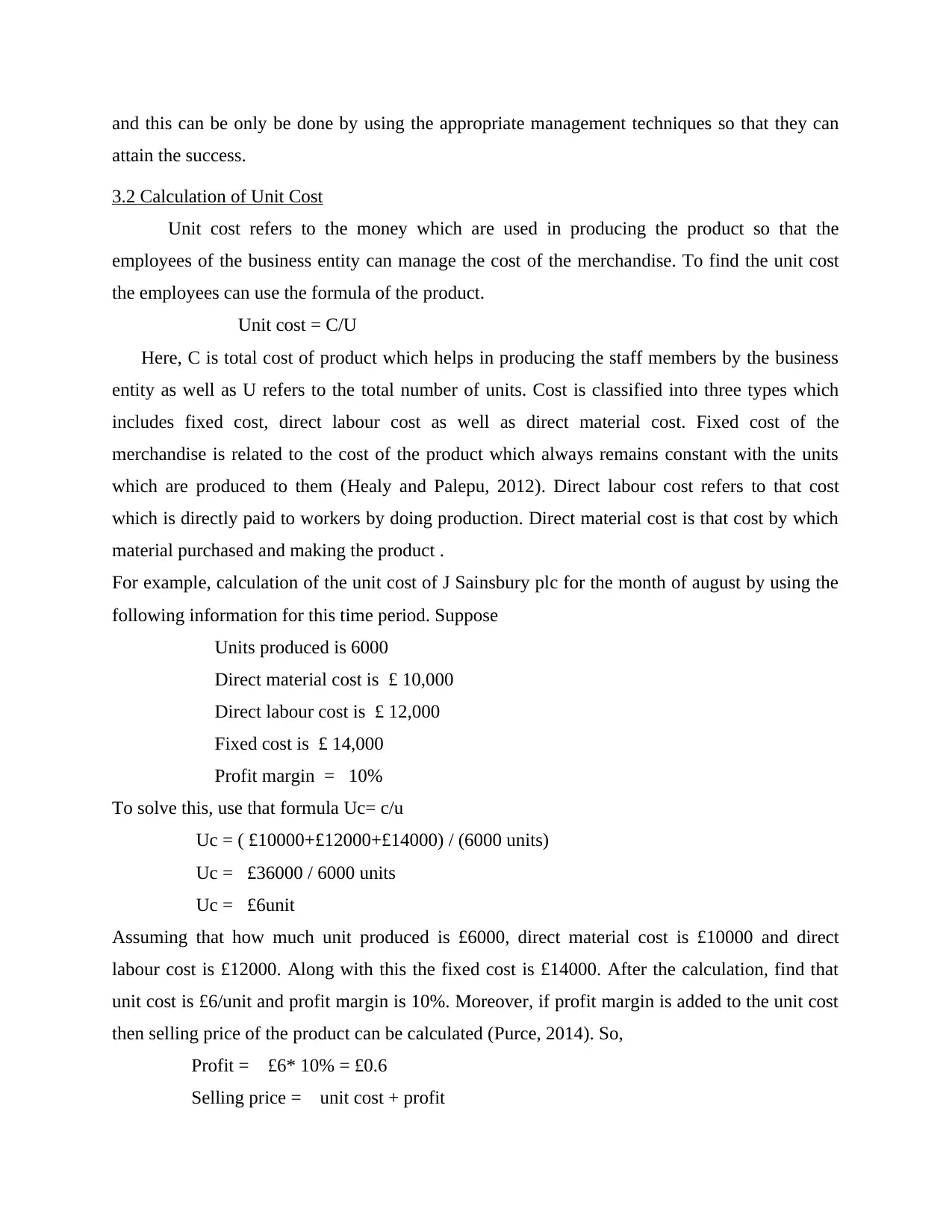
and this can be only be done by using the appropriate management techniques so that they can
attain the success.
3.2 Calculation of Unit Cost
Unit cost refers to the money which are used in producing the product so that the
employees of the business entity can manage the cost of the merchandise. To find the unit cost
the employees can use the formula of the product.
Unit cost = C/U
Here, C is total cost of product which helps in producing the staff members by the business
entity as well as U refers to the total number of units. Cost is classified into three types which
includes fixed cost, direct labour cost as well as direct material cost. Fixed cost of the
merchandise is related to the cost of the product which always remains constant with the units
which are produced to them (Healy and Palepu, 2012). Direct labour cost refers to that cost
which is directly paid to workers by doing production. Direct material cost is that cost by which
material purchased and making the product .
For example, calculation of the unit cost of J Sainsbury plc for the month of august by using the
following information for this time period. Suppose
Units produced is 6000
Direct material cost is £ 10,000
Direct labour cost is £ 12,000
Fixed cost is £ 14,000
Profit margin = 10%
To solve this, use that formula Uc= c/u
Uc = ( £10000+£12000+£14000) / (6000 units)
Uc = £36000 / 6000 units
Uc = £6unit
Assuming that how much unit produced is £6000, direct material cost is £10000 and direct
labour cost is £12000. Along with this the fixed cost is £14000. After the calculation, find that
unit cost is £6/unit and profit margin is 10%. Moreover, if profit margin is added to the unit cost
then selling price of the product can be calculated (Purce, 2014). So,
Profit = £6* 10% = £0.6
Selling price = unit cost + profit
attain the success.
3.2 Calculation of Unit Cost
Unit cost refers to the money which are used in producing the product so that the
employees of the business entity can manage the cost of the merchandise. To find the unit cost
the employees can use the formula of the product.
Unit cost = C/U
Here, C is total cost of product which helps in producing the staff members by the business
entity as well as U refers to the total number of units. Cost is classified into three types which
includes fixed cost, direct labour cost as well as direct material cost. Fixed cost of the
merchandise is related to the cost of the product which always remains constant with the units
which are produced to them (Healy and Palepu, 2012). Direct labour cost refers to that cost
which is directly paid to workers by doing production. Direct material cost is that cost by which
material purchased and making the product .
For example, calculation of the unit cost of J Sainsbury plc for the month of august by using the
following information for this time period. Suppose
Units produced is 6000
Direct material cost is £ 10,000
Direct labour cost is £ 12,000
Fixed cost is £ 14,000
Profit margin = 10%
To solve this, use that formula Uc= c/u
Uc = ( £10000+£12000+£14000) / (6000 units)
Uc = £36000 / 6000 units
Uc = £6unit
Assuming that how much unit produced is £6000, direct material cost is £10000 and direct
labour cost is £12000. Along with this the fixed cost is £14000. After the calculation, find that
unit cost is £6/unit and profit margin is 10%. Moreover, if profit margin is added to the unit cost
then selling price of the product can be calculated (Purce, 2014). So,
Profit = £6* 10% = £0.6
Selling price = unit cost + profit
Paraphrase This Document
Need a fresh take? Get an instant paraphrase of this document with our AI Paraphraser
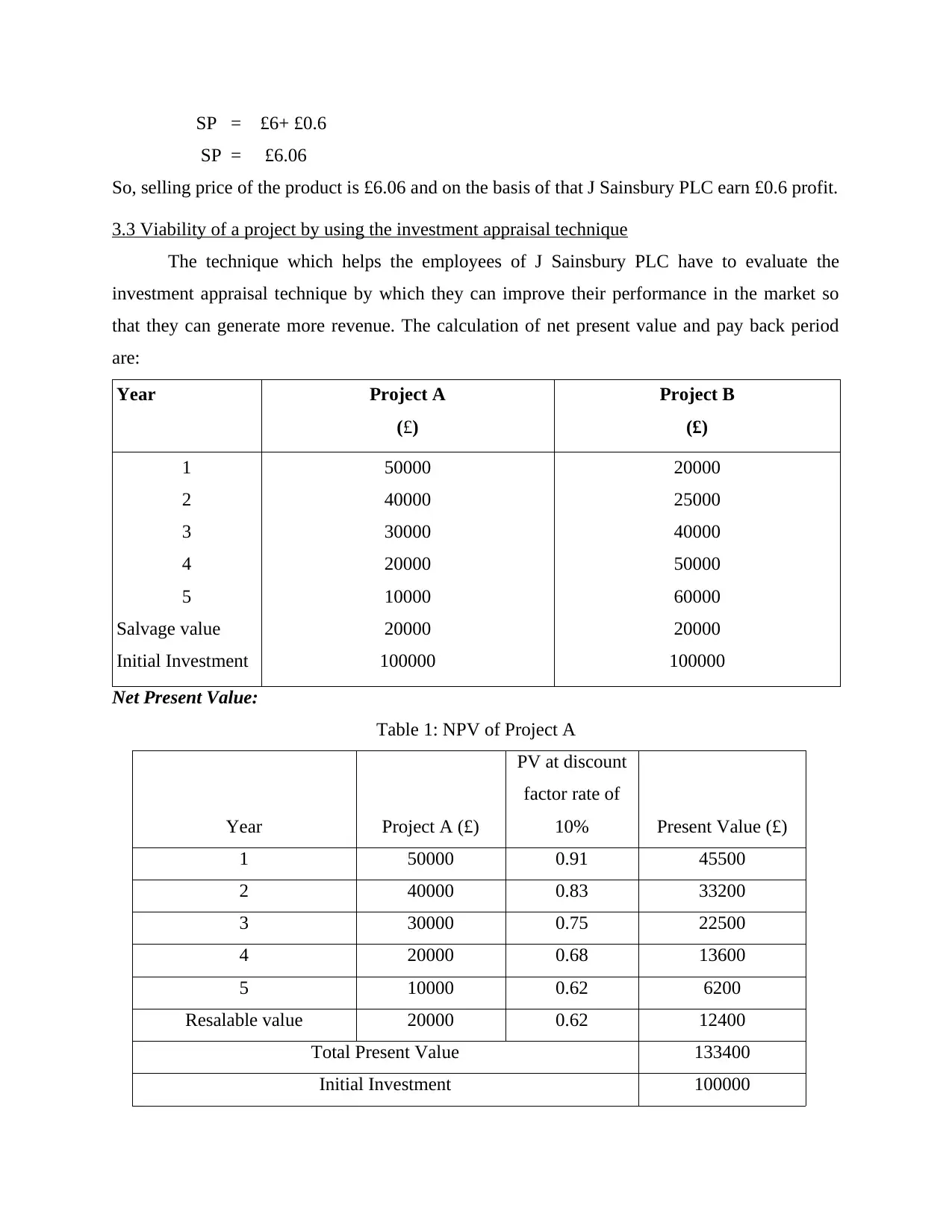
SP = £6+ £0.6
SP = £6.06
So, selling price of the product is £6.06 and on the basis of that J Sainsbury PLC earn £0.6 profit.
3.3 Viability of a project by using the investment appraisal technique
The technique which helps the employees of J Sainsbury PLC have to evaluate the
investment appraisal technique by which they can improve their performance in the market so
that they can generate more revenue. The calculation of net present value and pay back period
are:
Year Project A
(£)
Project B
(£)
1
2
3
4
5
Salvage value
Initial Investment
50000
40000
30000
20000
10000
20000
100000
20000
25000
40000
50000
60000
20000
100000
Net Present Value:
Table 1: NPV of Project A
Year Project A (£)
PV at discount
factor rate of
10% Present Value (£)
1 50000 0.91 45500
2 40000 0.83 33200
3 30000 0.75 22500
4 20000 0.68 13600
5 10000 0.62 6200
Resalable value 20000 0.62 12400
Total Present Value 133400
Initial Investment 100000
SP = £6.06
So, selling price of the product is £6.06 and on the basis of that J Sainsbury PLC earn £0.6 profit.
3.3 Viability of a project by using the investment appraisal technique
The technique which helps the employees of J Sainsbury PLC have to evaluate the
investment appraisal technique by which they can improve their performance in the market so
that they can generate more revenue. The calculation of net present value and pay back period
are:
Year Project A
(£)
Project B
(£)
1
2
3
4
5
Salvage value
Initial Investment
50000
40000
30000
20000
10000
20000
100000
20000
25000
40000
50000
60000
20000
100000
Net Present Value:
Table 1: NPV of Project A
Year Project A (£)
PV at discount
factor rate of
10% Present Value (£)
1 50000 0.91 45500
2 40000 0.83 33200
3 30000 0.75 22500
4 20000 0.68 13600
5 10000 0.62 6200
Resalable value 20000 0.62 12400
Total Present Value 133400
Initial Investment 100000
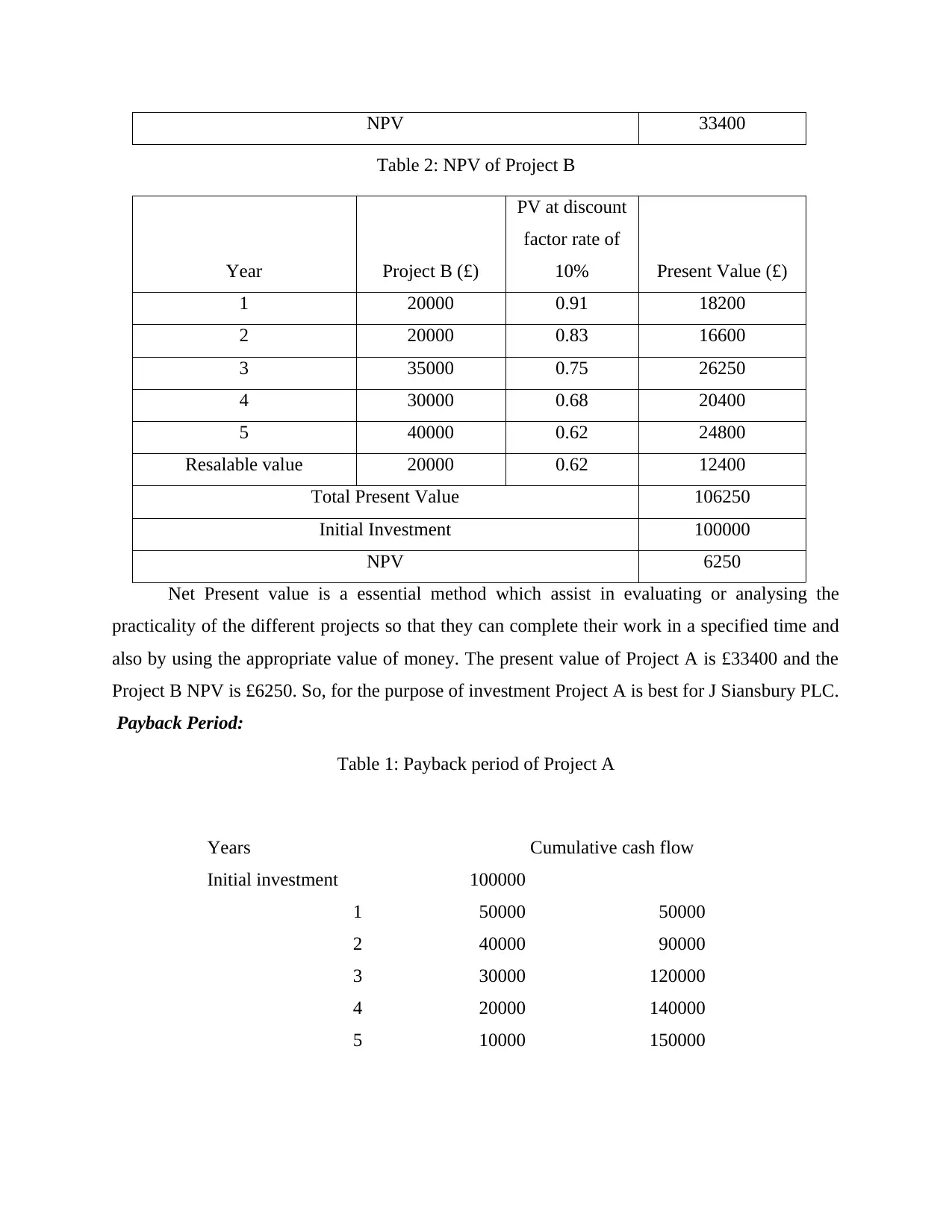
NPV 33400
Table 2: NPV of Project B
Year Project B (£)
PV at discount
factor rate of
10% Present Value (£)
1 20000 0.91 18200
2 20000 0.83 16600
3 35000 0.75 26250
4 30000 0.68 20400
5 40000 0.62 24800
Resalable value 20000 0.62 12400
Total Present Value 106250
Initial Investment 100000
NPV 6250
Net Present value is a essential method which assist in evaluating or analysing the
practicality of the different projects so that they can complete their work in a specified time and
also by using the appropriate value of money. The present value of Project A is £33400 and the
Project B NPV is £6250. So, for the purpose of investment Project A is best for J Siansbury PLC.
Payback Period:
Table 1: Payback period of Project A
Years Cumulative cash flow
Initial investment 100000
1 50000 50000
2 40000 90000
3 30000 120000
4 20000 140000
5 10000 150000
Table 2: NPV of Project B
Year Project B (£)
PV at discount
factor rate of
10% Present Value (£)
1 20000 0.91 18200
2 20000 0.83 16600
3 35000 0.75 26250
4 30000 0.68 20400
5 40000 0.62 24800
Resalable value 20000 0.62 12400
Total Present Value 106250
Initial Investment 100000
NPV 6250
Net Present value is a essential method which assist in evaluating or analysing the
practicality of the different projects so that they can complete their work in a specified time and
also by using the appropriate value of money. The present value of Project A is £33400 and the
Project B NPV is £6250. So, for the purpose of investment Project A is best for J Siansbury PLC.
Payback Period:
Table 1: Payback period of Project A
Years Cumulative cash flow
Initial investment 100000
1 50000 50000
2 40000 90000
3 30000 120000
4 20000 140000
5 10000 150000
⊘ This is a preview!⊘
Do you want full access?
Subscribe today to unlock all pages.

Trusted by 1+ million students worldwide
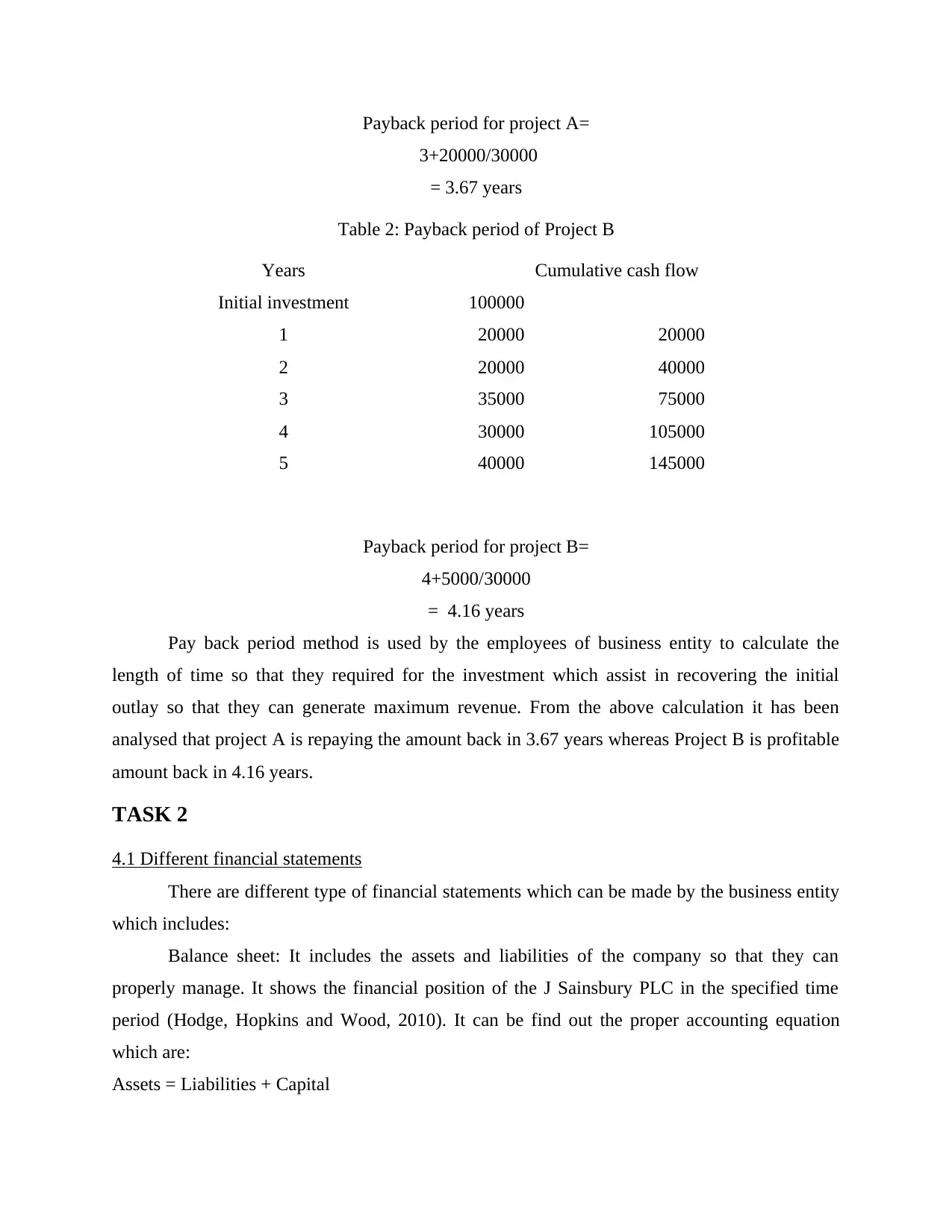
Payback period for project A=
3+20000/30000
= 3.67 years
Table 2: Payback period of Project B
Years Cumulative cash flow
Initial investment 100000
1 20000 20000
2 20000 40000
3 35000 75000
4 30000 105000
5 40000 145000
Payback period for project B=
4+5000/30000
= 4.16 years
Pay back period method is used by the employees of business entity to calculate the
length of time so that they required for the investment which assist in recovering the initial
outlay so that they can generate maximum revenue. From the above calculation it has been
analysed that project A is repaying the amount back in 3.67 years whereas Project B is profitable
amount back in 4.16 years.
TASK 2
4.1 Different financial statements
There are different type of financial statements which can be made by the business entity
which includes:
Balance sheet: It includes the assets and liabilities of the company so that they can
properly manage. It shows the financial position of the J Sainsbury PLC in the specified time
period (Hodge, Hopkins and Wood, 2010). It can be find out the proper accounting equation
which are:
Assets = Liabilities + Capital
3+20000/30000
= 3.67 years
Table 2: Payback period of Project B
Years Cumulative cash flow
Initial investment 100000
1 20000 20000
2 20000 40000
3 35000 75000
4 30000 105000
5 40000 145000
Payback period for project B=
4+5000/30000
= 4.16 years
Pay back period method is used by the employees of business entity to calculate the
length of time so that they required for the investment which assist in recovering the initial
outlay so that they can generate maximum revenue. From the above calculation it has been
analysed that project A is repaying the amount back in 3.67 years whereas Project B is profitable
amount back in 4.16 years.
TASK 2
4.1 Different financial statements
There are different type of financial statements which can be made by the business entity
which includes:
Balance sheet: It includes the assets and liabilities of the company so that they can
properly manage. It shows the financial position of the J Sainsbury PLC in the specified time
period (Hodge, Hopkins and Wood, 2010). It can be find out the proper accounting equation
which are:
Assets = Liabilities + Capital
Paraphrase This Document
Need a fresh take? Get an instant paraphrase of this document with our AI Paraphraser
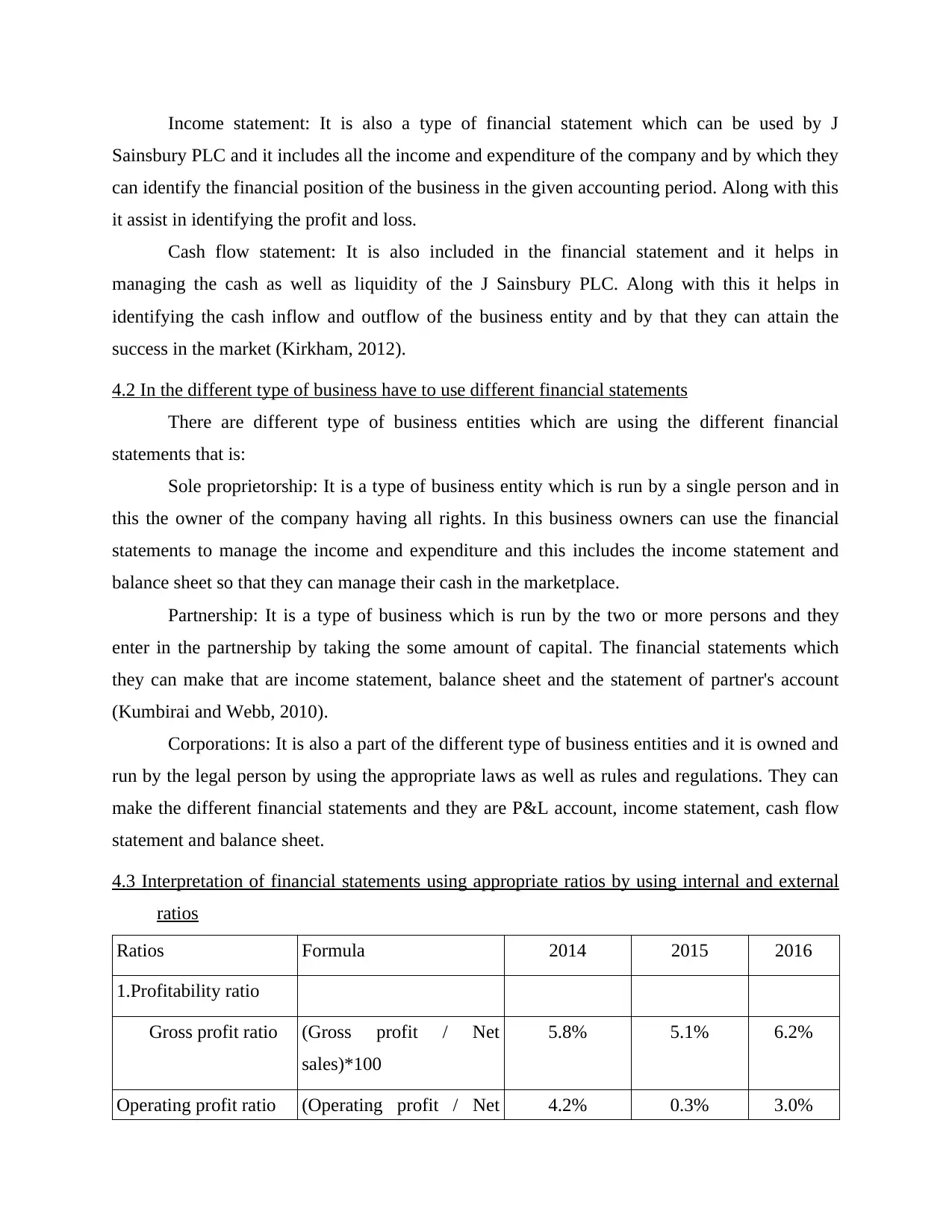
Income statement: It is also a type of financial statement which can be used by J
Sainsbury PLC and it includes all the income and expenditure of the company and by which they
can identify the financial position of the business in the given accounting period. Along with this
it assist in identifying the profit and loss.
Cash flow statement: It is also included in the financial statement and it helps in
managing the cash as well as liquidity of the J Sainsbury PLC. Along with this it helps in
identifying the cash inflow and outflow of the business entity and by that they can attain the
success in the market (Kirkham, 2012).
4.2 In the different type of business have to use different financial statements
There are different type of business entities which are using the different financial
statements that is:
Sole proprietorship: It is a type of business entity which is run by a single person and in
this the owner of the company having all rights. In this business owners can use the financial
statements to manage the income and expenditure and this includes the income statement and
balance sheet so that they can manage their cash in the marketplace.
Partnership: It is a type of business which is run by the two or more persons and they
enter in the partnership by taking the some amount of capital. The financial statements which
they can make that are income statement, balance sheet and the statement of partner's account
(Kumbirai and Webb, 2010).
Corporations: It is also a part of the different type of business entities and it is owned and
run by the legal person by using the appropriate laws as well as rules and regulations. They can
make the different financial statements and they are P&L account, income statement, cash flow
statement and balance sheet.
4.3 Interpretation of financial statements using appropriate ratios by using internal and external
ratios
Ratios Formula 2014 2015 2016
1.Profitability ratio
Gross profit ratio (Gross profit / Net
sales)*100
5.8% 5.1% 6.2%
Operating profit ratio (Operating profit / Net 4.2% 0.3% 3.0%
Sainsbury PLC and it includes all the income and expenditure of the company and by which they
can identify the financial position of the business in the given accounting period. Along with this
it assist in identifying the profit and loss.
Cash flow statement: It is also included in the financial statement and it helps in
managing the cash as well as liquidity of the J Sainsbury PLC. Along with this it helps in
identifying the cash inflow and outflow of the business entity and by that they can attain the
success in the market (Kirkham, 2012).
4.2 In the different type of business have to use different financial statements
There are different type of business entities which are using the different financial
statements that is:
Sole proprietorship: It is a type of business entity which is run by a single person and in
this the owner of the company having all rights. In this business owners can use the financial
statements to manage the income and expenditure and this includes the income statement and
balance sheet so that they can manage their cash in the marketplace.
Partnership: It is a type of business which is run by the two or more persons and they
enter in the partnership by taking the some amount of capital. The financial statements which
they can make that are income statement, balance sheet and the statement of partner's account
(Kumbirai and Webb, 2010).
Corporations: It is also a part of the different type of business entities and it is owned and
run by the legal person by using the appropriate laws as well as rules and regulations. They can
make the different financial statements and they are P&L account, income statement, cash flow
statement and balance sheet.
4.3 Interpretation of financial statements using appropriate ratios by using internal and external
ratios
Ratios Formula 2014 2015 2016
1.Profitability ratio
Gross profit ratio (Gross profit / Net
sales)*100
5.8% 5.1% 6.2%
Operating profit ratio (Operating profit / Net 4.2% 0.3% 3.0%
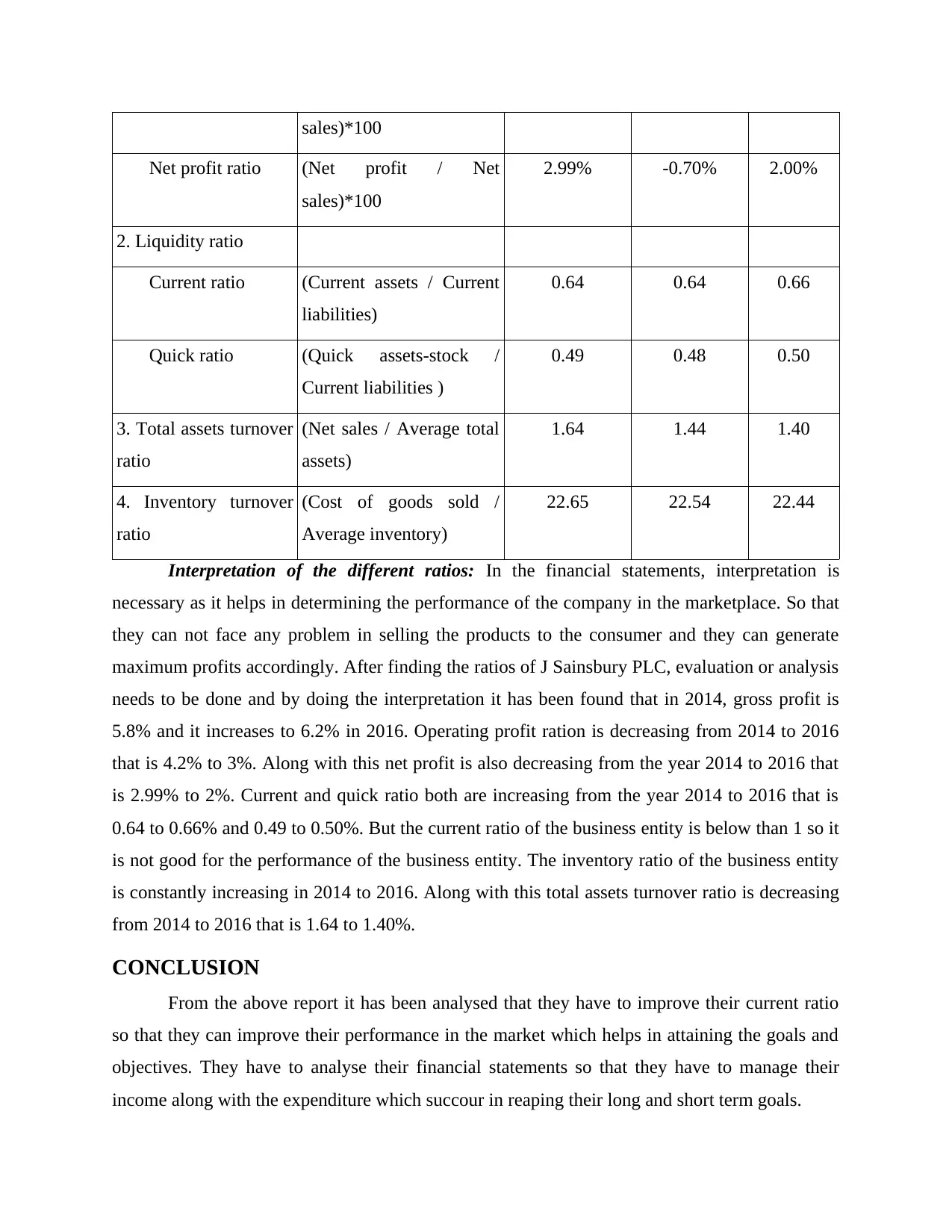
sales)*100
Net profit ratio (Net profit / Net
sales)*100
2.99% -0.70% 2.00%
2. Liquidity ratio
Current ratio (Current assets / Current
liabilities)
0.64 0.64 0.66
Quick ratio (Quick assets-stock /
Current liabilities )
0.49 0.48 0.50
3. Total assets turnover
ratio
(Net sales / Average total
assets)
1.64 1.44 1.40
4. Inventory turnover
ratio
(Cost of goods sold /
Average inventory)
22.65 22.54 22.44
Interpretation of the different ratios: In the financial statements, interpretation is
necessary as it helps in determining the performance of the company in the marketplace. So that
they can not face any problem in selling the products to the consumer and they can generate
maximum profits accordingly. After finding the ratios of J Sainsbury PLC, evaluation or analysis
needs to be done and by doing the interpretation it has been found that in 2014, gross profit is
5.8% and it increases to 6.2% in 2016. Operating profit ration is decreasing from 2014 to 2016
that is 4.2% to 3%. Along with this net profit is also decreasing from the year 2014 to 2016 that
is 2.99% to 2%. Current and quick ratio both are increasing from the year 2014 to 2016 that is
0.64 to 0.66% and 0.49 to 0.50%. But the current ratio of the business entity is below than 1 so it
is not good for the performance of the business entity. The inventory ratio of the business entity
is constantly increasing in 2014 to 2016. Along with this total assets turnover ratio is decreasing
from 2014 to 2016 that is 1.64 to 1.40%.
CONCLUSION
From the above report it has been analysed that they have to improve their current ratio
so that they can improve their performance in the market which helps in attaining the goals and
objectives. They have to analyse their financial statements so that they have to manage their
income along with the expenditure which succour in reaping their long and short term goals.
Net profit ratio (Net profit / Net
sales)*100
2.99% -0.70% 2.00%
2. Liquidity ratio
Current ratio (Current assets / Current
liabilities)
0.64 0.64 0.66
Quick ratio (Quick assets-stock /
Current liabilities )
0.49 0.48 0.50
3. Total assets turnover
ratio
(Net sales / Average total
assets)
1.64 1.44 1.40
4. Inventory turnover
ratio
(Cost of goods sold /
Average inventory)
22.65 22.54 22.44
Interpretation of the different ratios: In the financial statements, interpretation is
necessary as it helps in determining the performance of the company in the marketplace. So that
they can not face any problem in selling the products to the consumer and they can generate
maximum profits accordingly. After finding the ratios of J Sainsbury PLC, evaluation or analysis
needs to be done and by doing the interpretation it has been found that in 2014, gross profit is
5.8% and it increases to 6.2% in 2016. Operating profit ration is decreasing from 2014 to 2016
that is 4.2% to 3%. Along with this net profit is also decreasing from the year 2014 to 2016 that
is 2.99% to 2%. Current and quick ratio both are increasing from the year 2014 to 2016 that is
0.64 to 0.66% and 0.49 to 0.50%. But the current ratio of the business entity is below than 1 so it
is not good for the performance of the business entity. The inventory ratio of the business entity
is constantly increasing in 2014 to 2016. Along with this total assets turnover ratio is decreasing
from 2014 to 2016 that is 1.64 to 1.40%.
CONCLUSION
From the above report it has been analysed that they have to improve their current ratio
so that they can improve their performance in the market which helps in attaining the goals and
objectives. They have to analyse their financial statements so that they have to manage their
income along with the expenditure which succour in reaping their long and short term goals.
⊘ This is a preview!⊘
Do you want full access?
Subscribe today to unlock all pages.

Trusted by 1+ million students worldwide
1 out of 13
Related Documents
Your All-in-One AI-Powered Toolkit for Academic Success.
+13062052269
info@desklib.com
Available 24*7 on WhatsApp / Email
![[object Object]](/_next/static/media/star-bottom.7253800d.svg)
Unlock your academic potential
Copyright © 2020–2025 A2Z Services. All Rights Reserved. Developed and managed by ZUCOL.





